What a way to celebrate spring - or summer, or a birthday, a graduation, Mother's Day, Easter, or just a special Sunday! Mandarinen Sahnetorte is a German cream torte dotted with juicy mandarin orange segments. It's light and creamy and fluffy, melting on your tongue in a divine cloud of bright citrus tanginess.
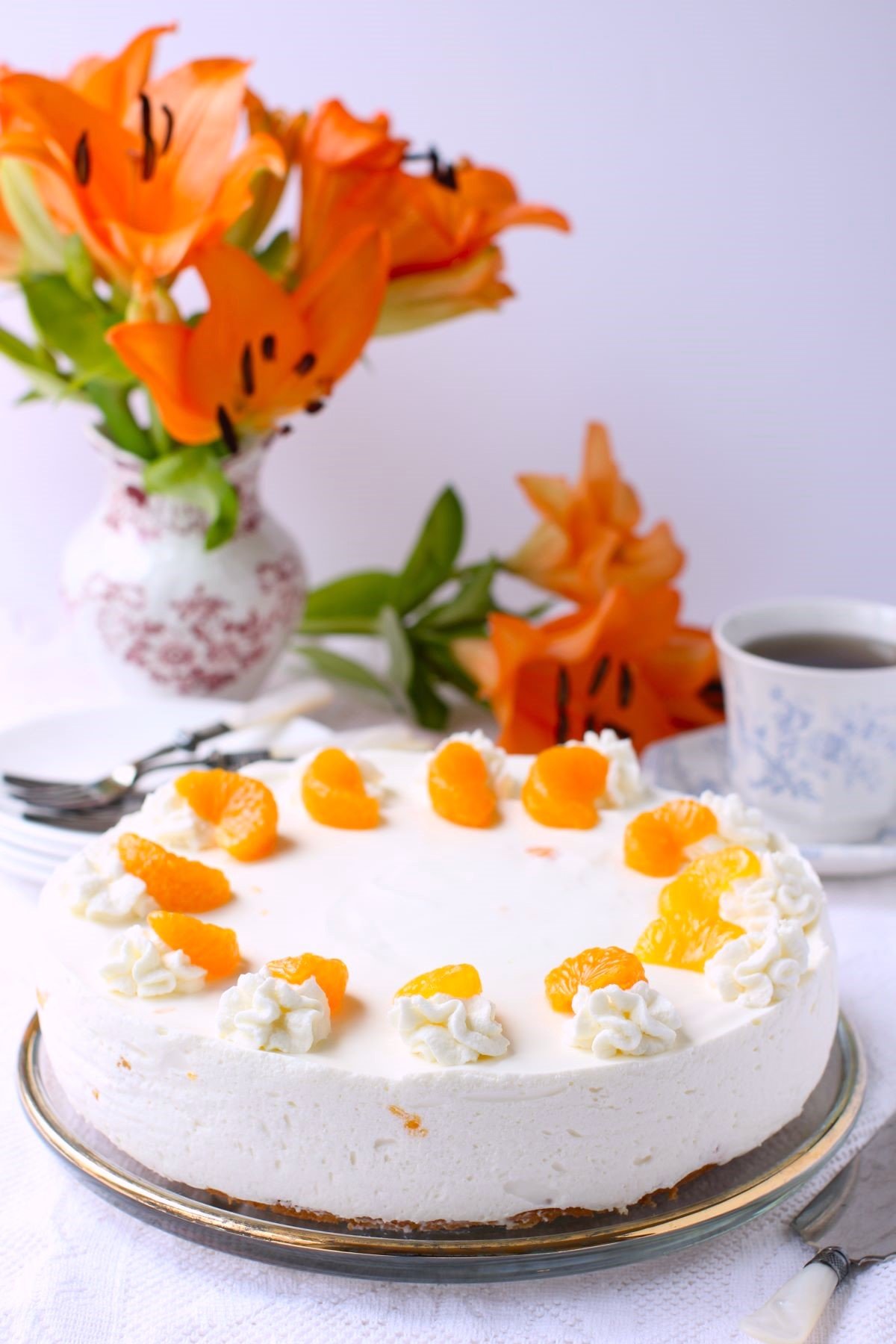
Is food your love language? Is preparing a meal for your loved ones how you show how much you care about them? Do you enjoy spending time making something special to put a smile on the faces of your friends and family.
Taking the little bit of extra time to make this heavenly German Cream Torte will surely bring joy to whomever you make it for. German torten are always special cakes, made with layers of light or nutty sponges, mousses, and creams. This Mandarinen Sahne Torte is a version of a Käsesahnetorte, an unbaked cake with a lightly set filling, usually made with a mild, fresh cheese called Quark. In this version full-fat Greek yogurt provides the same tangy flavour profile (however, if you can find true German-style Quark, go ahead and use that instead of the yogurt). The torte base is a light, delicate baked sponge cake (Biscuitboden), providing a textural foil to the creamy filling which is dotted with juicy mandarin orange segments.

If you're looking for some other lovey German Torten, you might love these:
- Eierlikörtorte (Egg Liqueur Torte)
- Feuerwehrkuchen (Fire Brigade Cake)
- Baumkuchen (German Tree Ring Cake)
- Bayrischer Apfelkuchen (Bavarian Apple Cake)
- Lebkuchen Bûche De Noël
- German Chocolate Cake (not actually German, but like a German torte)
What You'll Need for your Mandarin Cream Torte
You don't need a lot of special ingredients to make this luscious torte, and if you follow the easy, detailed instructions below, you will have success every time making this special cake for your friends and family.
This recipe was given me by my German friend Ruth (I first tasted it and loved it at her home), and I've adapted it to work with our more easily accessible North American ingredients. You can use German Quark (a fresh cheese) as in the original recipe, if you can find it. Greek yogurt makes a very delicious substitute that is quite similar.
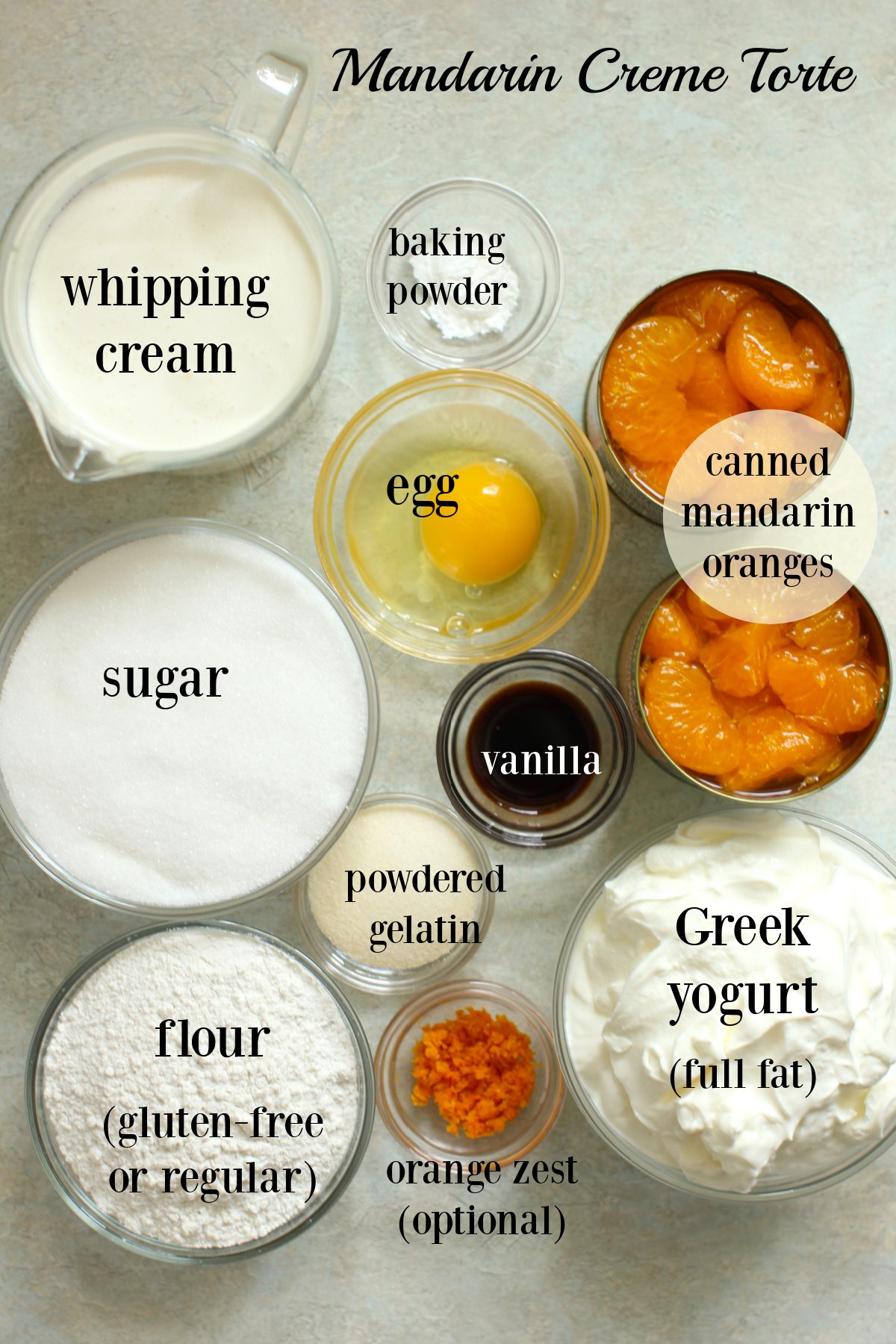
The base for this cream torte turns out equally well with regular all-purpose flour or a good gluten-free flour blend. The sponge cake base layer is meant to be slightly dry, rather than moist, as it will support the filling better and it will soften up as it chills with the filling added.
Ingredient tip: It's best to use canned mandarin oranges in light syrup. The segments in the ones canned in their own juice are usually more broken up, and the juice will colour the cake more orange rather than a nice snowy white.

Guide for Making a Mandarin Sahnetorte (Cream Torte)
First thing you'll need to do is drain the two cans of mandarin oranges so you can collect the juice, which you'll need for the base and filling. You will need 1 cup of juice, so if you have less, top it up with water. If you have more, discard the extra. And pick out 12 perfect segments to decorate the cake later (cover them and stick them in the fridge).
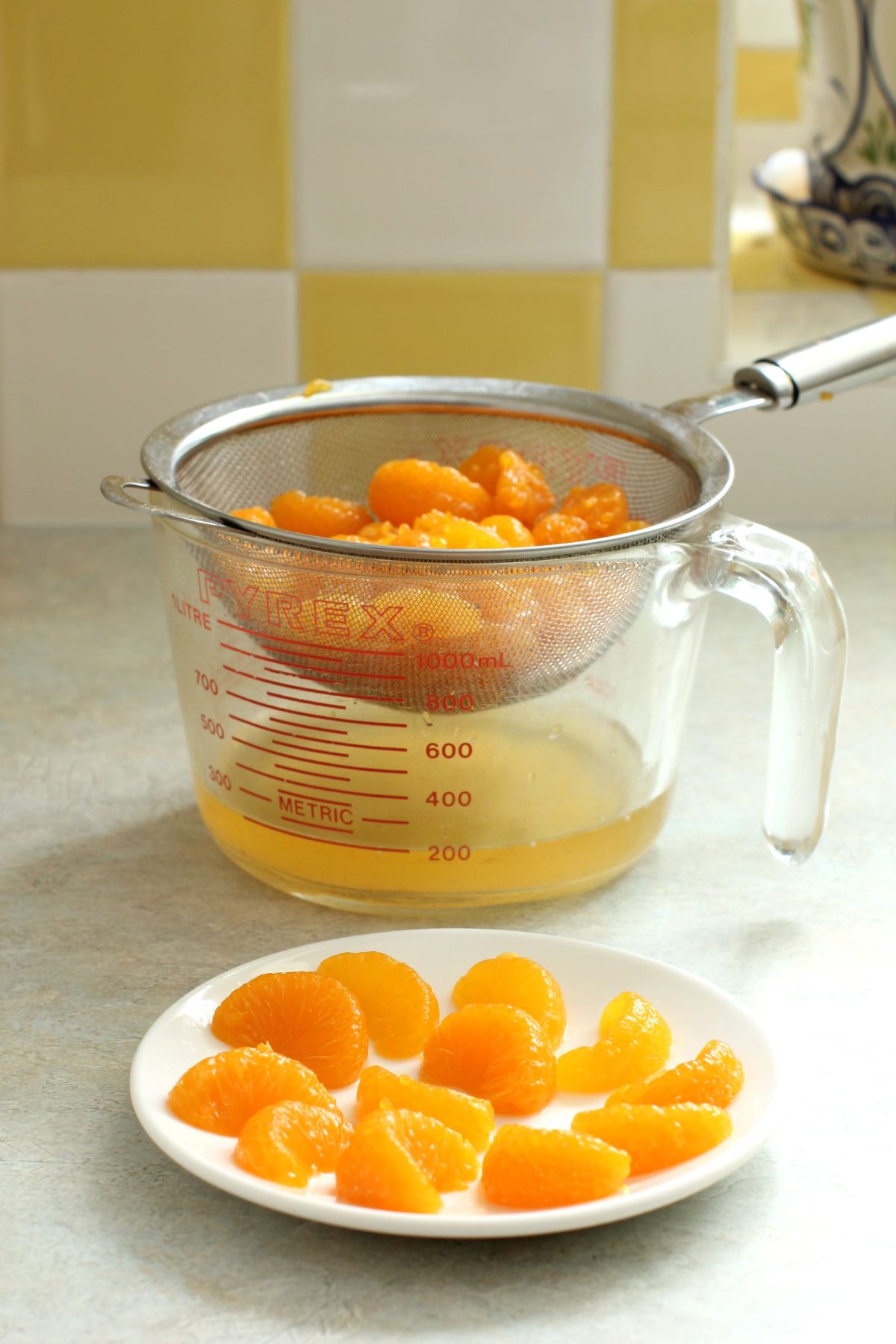
Grease a springform pan and preheat the oven.
Then make the Biscuitboden (the sponge base layer). Whip up a whole egg with a bit of water until it's become a big fluffy bowlful of foam (beat it for 3 to 4 minutes). Then add a bit of sugar, some vanilla, orange zest, and a couple tablespoons of the drained mandarin liquid.
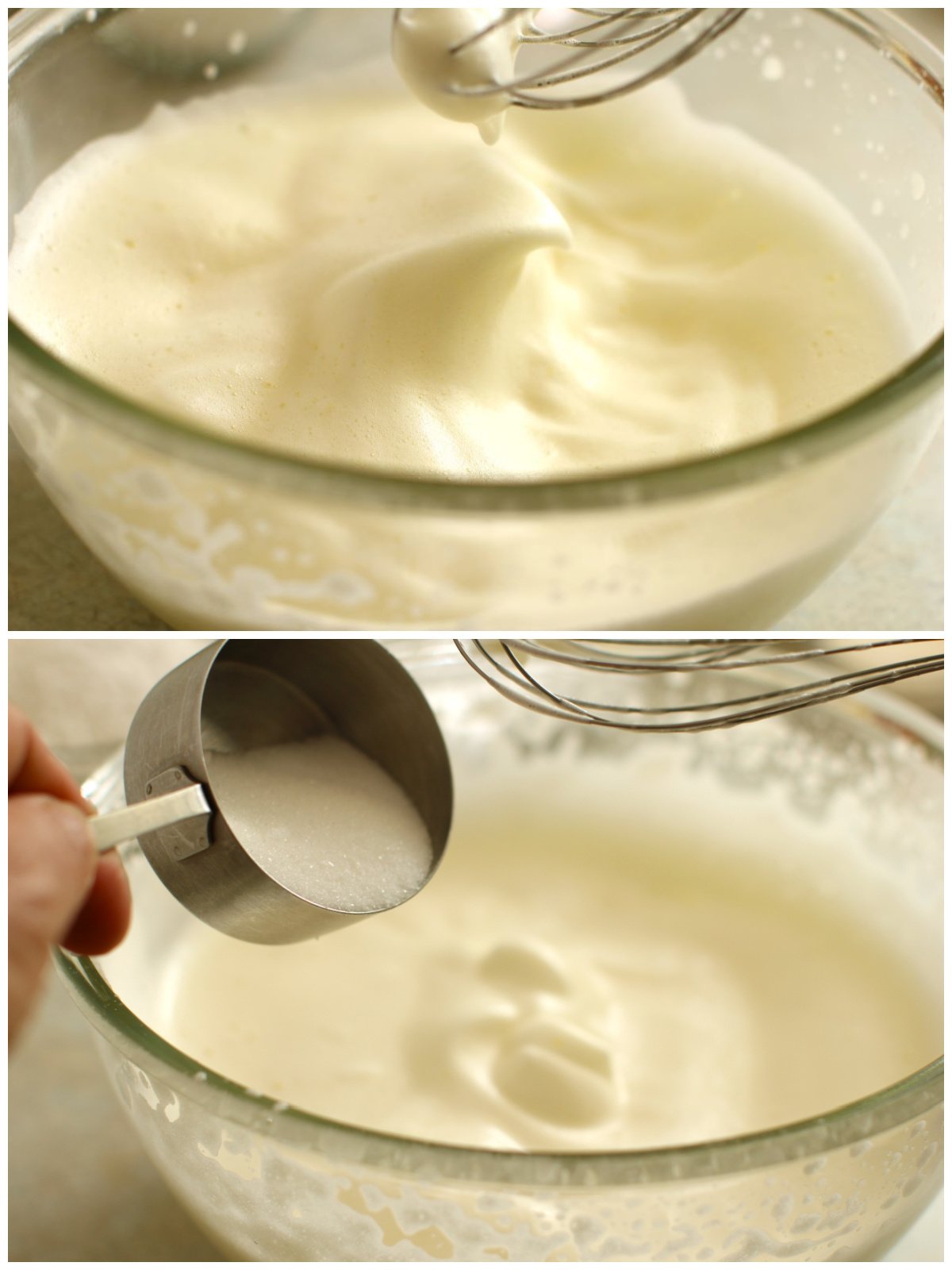
Now sift the flour over the batter and fold it in gently. Pour it into the greased springform pan. Spread it around quickly as the baking powder will make the batter foam up. Don't worry if you can't get it perfectly smooth - just do the best you can and don't fuss with it too much.
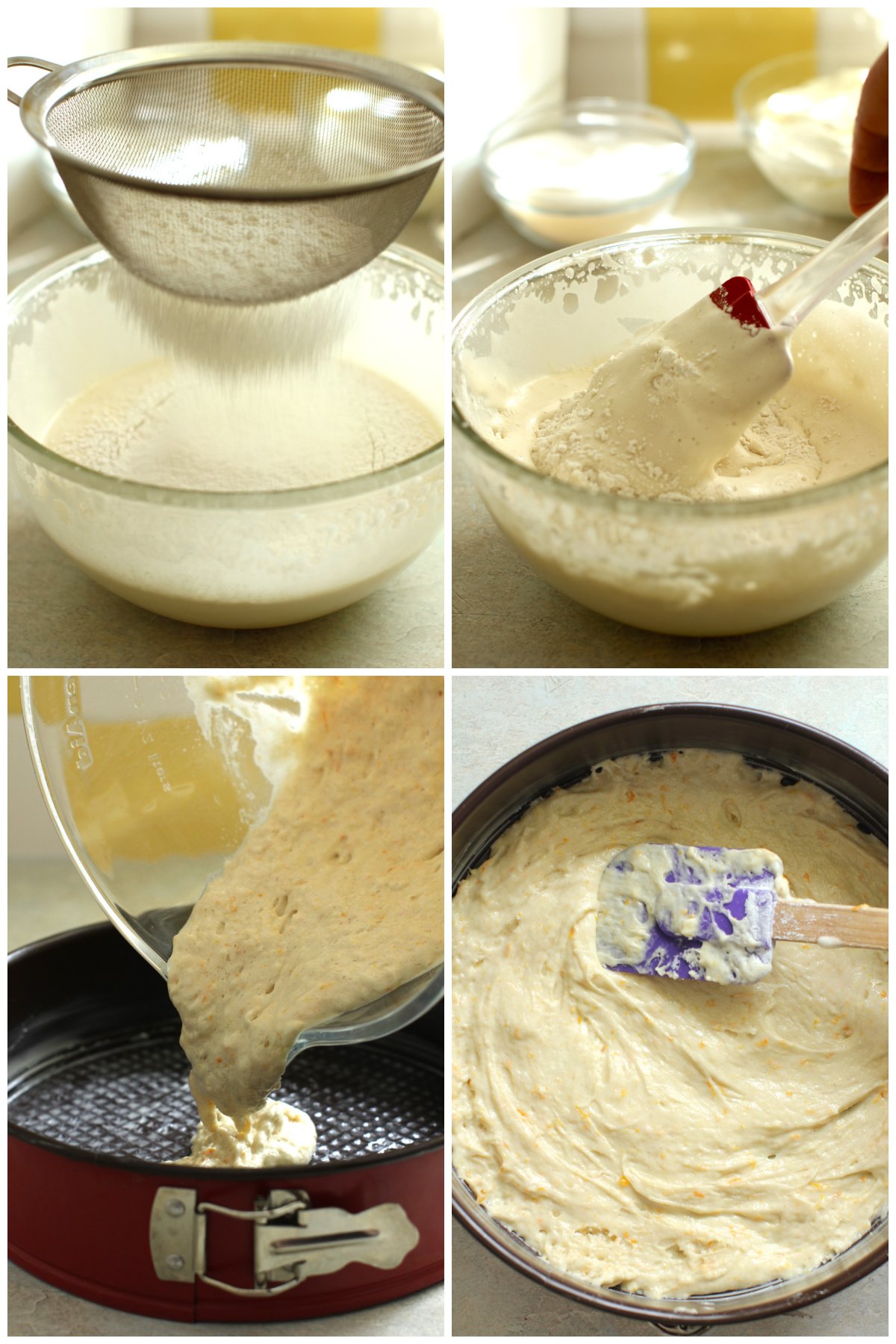
Bake the base layer and let it cool in the pan. Then remove the sides of the pan and run a thin spatula under the cake to loosen it from the bottom to make it easier to remove later. Cut two long strips of parchment paper and slide them down into the pan around the cake, overlapping by an inch or two. They will stay in place if the pan was greased. The strips will keep the filling edges nice and smooth.
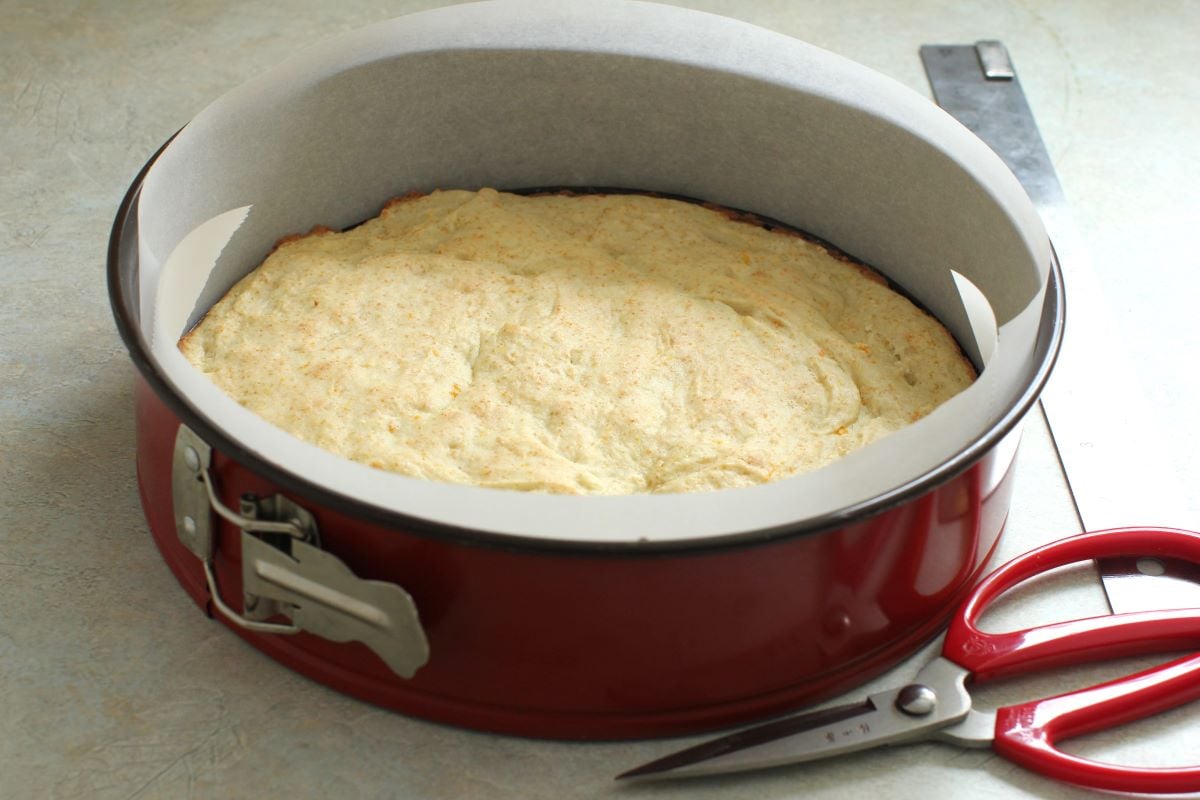
Now Make the Mandarin Cream Torte Filling
Pour some of the drained mandarin juice into a small saucepan and sprinkle the powdered gelatin over it. Let it thicken, then heat it gently until the gelatin dissolves. Add in some more cool mandarin juice, sugar, and the Greek yogurt. Stir it all into a smooth liquid.
Whip up the cream, then pour that luscious gelatin/yogurt cream over it. Fold it into the whipped cream, then remove about a half cup of the moussy mixture and put it into a small piping bag fitted with a star tip or put it into a ziptop plastic sandwich bag. To keep the mouse from coming out of the piping bag, twist the tip before filling the bag and set it into a cup. Tie or clip the end shut and keep the piping bag in the fridge. It will stay soft enough to pipe onto the cake once it is set.

Fold the drained mandarin orange segments into the yogurt cream. Pour the fluffy mandarin mousse on top of the cooled sponge base in the springform pan and smooth the top. Set it into the fridge to chill for 3 or 4 hours.
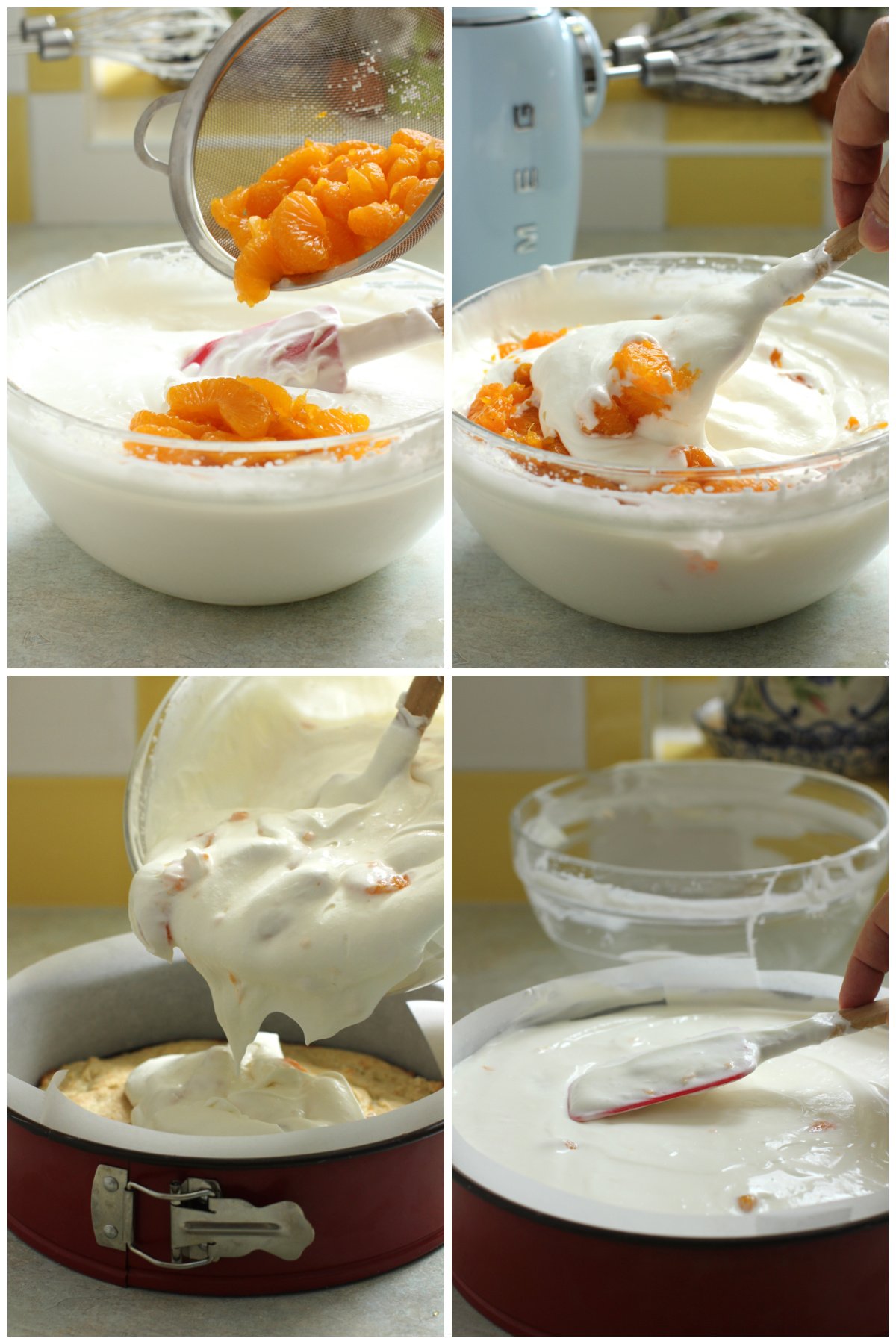
When the cream torte is set, remove the springform sides and carefully peel off the parchment paper strips, then add the finishing touches. Pipe the reserved mousse into 12 little rosettes around the cake. If you have put the mousse into a plastic bag, snip off one corner and make little swirled mounds instead. Add the reserved orange segments onto each mound.
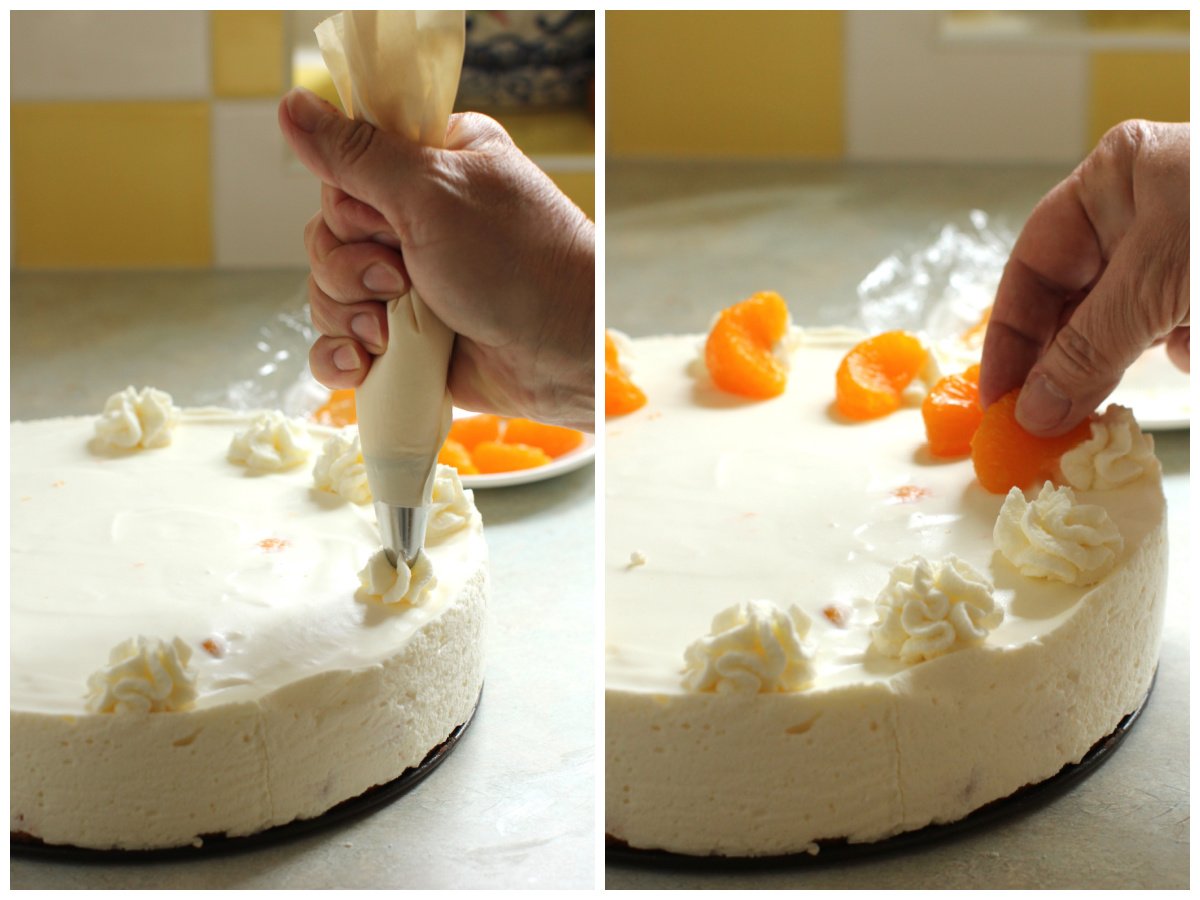
Ta-da! Your beautiful German Mandarin Cream Torte (Mandarinen Sahnetorte) is ready to enjoy. 🧡
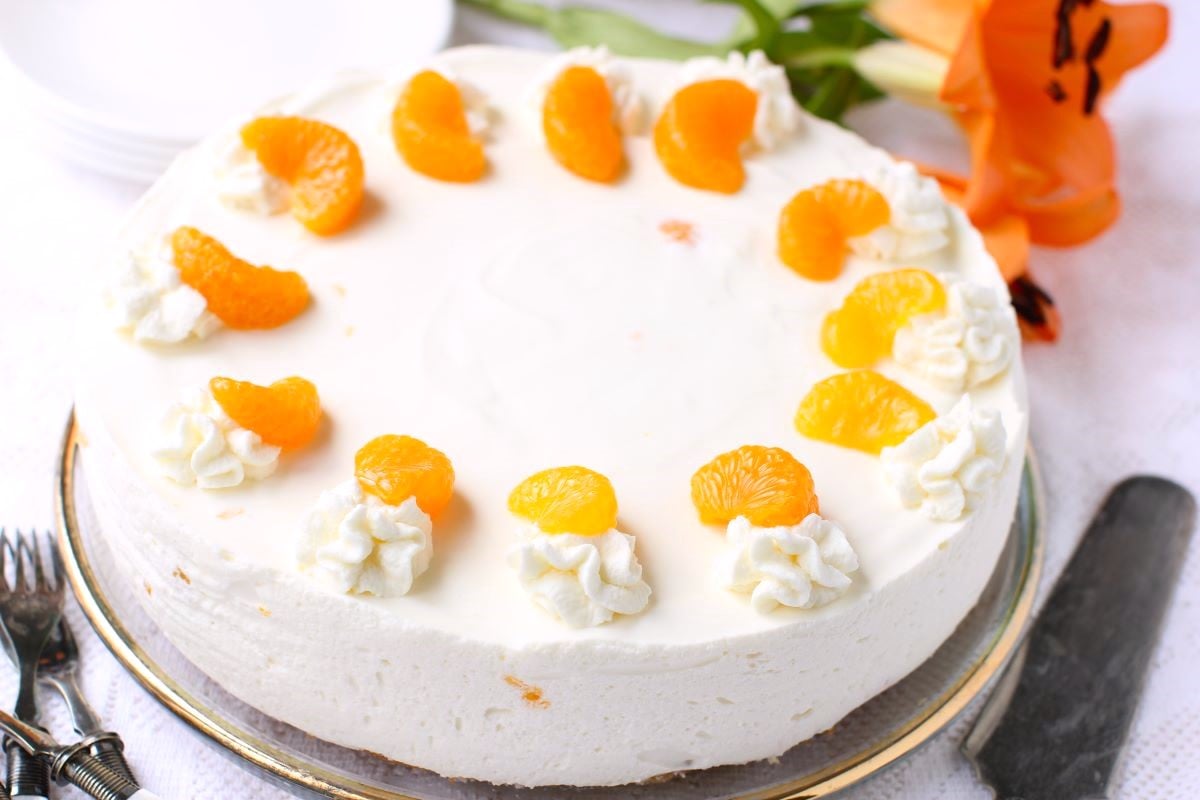
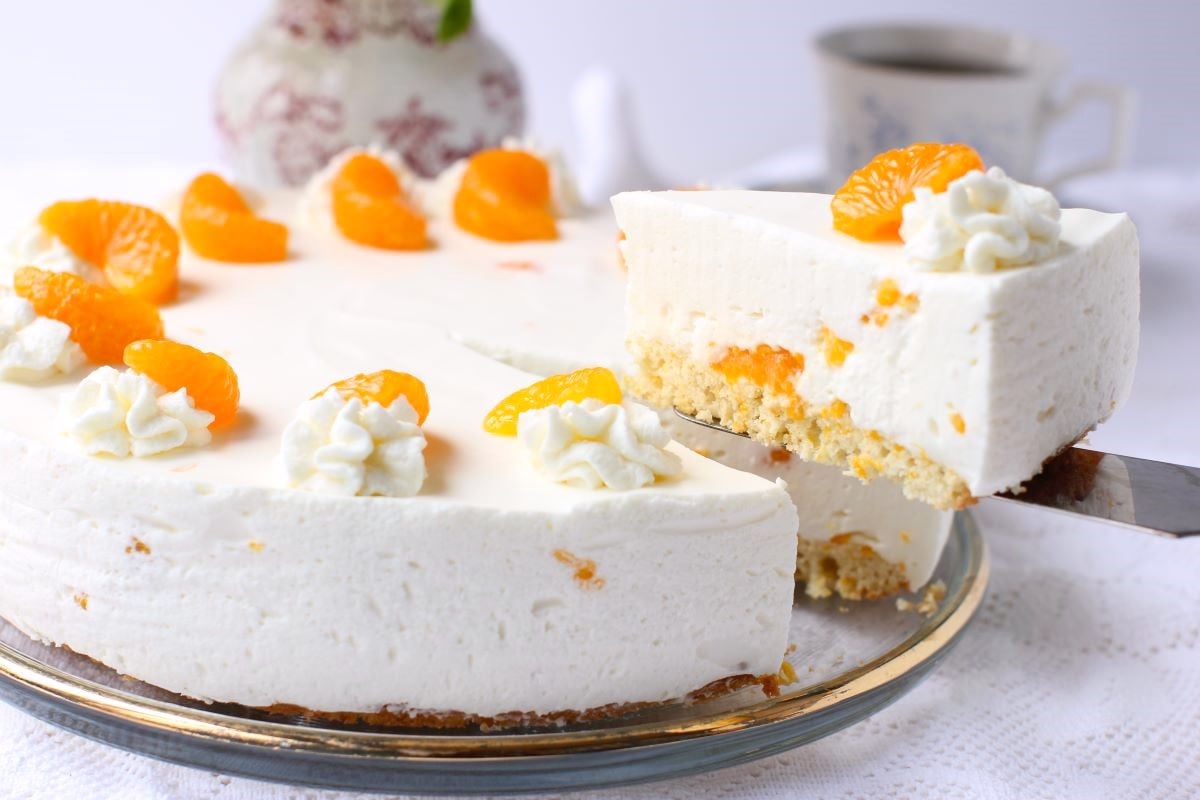

Want to receive new Kitchen Frau recipes directly to your email as soon as they're posted? Sign up here and you’ll get bits of news updates on what's happening in my kitchen and garden, plus a handy and useful kitchen tip along with each recipe, too. (No spam ever.)
If you like my recipes, follow me on Instagram, Pinterest, Twitter, and Facebook. You’d make my day. 😊
Guten Appetit!

Mandarinen-Sahnetorte (German Mandarin Cream Torte)
Equipment
- springform pan, 10-inch (26 cm, inside measurement)
- parchment paper
- piping bag with star tip or small ziptop plastic food bag
Ingredients
- 2 cans (284 ml/10 oz each) mandarin orange sections in light syrup, drained and juice reserved
for the Biscuitboden base:
- 1 large egg
- 2 tablespoons water
- ⅓ cup (70 g) sugar
- 1 teaspoon pure vanilla extract
- 1 teaspoon finely grated orange zest, optional
- 2 tablespoons (30 ml) drained mandarin juice
- ¾ cup (100 g) gluten-free flour blend or regular flour for non-gluten-free
- ½ teaspoon baking powder
for the Mandarin Cream filling:
- ½ cup + 6 tablespoons (120 ml + 90 ml) drained Mandarin juice, divided
- 5½ teaspoons (16 g) powdered gelatin (2½ packages)
- 1 cup (200 g) sugar
- 2 cups (475 g) full-fat Greek yogurt (6-10% milk fat)
- 1 teaspoon pure vanilla extract
- 2 cups (480 ml) whipping cream
- drained mandarin orange sections from the 2 cans listed above
Instructions
- Pour the contents of the two cans of mandarin oranges into a sieve or colander set over a bowl to catch the liquid. Pick out 12 perfectly shaped orange segments to use on top of the cake when it is finished. Put them into a small bowl, cover, and refrigerate them for later.You will need 1 cup (240 ml) of drained mandarin juice. Discard any extra. If you don't have enough, add water or orange juice to make up 1 cup.
- Preheat the oven to 350℉ (180℃). Grease the springform pan with about 2 teaspoons of butter or use cooking oil spray to grease it.
To make the Biscuitboden (base):
- Whip the egg with the 2 tablespoons of water on high speed with an electric mixer until it is pale and fluffy and about 5 to 6 times its initial volume. This will take about 3-4 minutes.
- Gradually beat in the ⅓ cup of sugar and continue beating until the mixture is thick and glossy (another 1-2 minutes).
- Add vanilla, orange zest, and 2 tablespoons of drained mandarin juice (the mixture will thin out now).
- Sift over the flour and baking powder and fold it in gently with a spatula until no flour is visible.
- Scrape the batter into the greased springform pan and spread it around evenly on the bottom. Work quickly, as the baking powder will cause the dough to get foamy and it will be a bit difficult to spread, but do the best you can - it doesn't have to be perfectly even.
- Bake for 15-18 minutes, until the cake gets golden around the edges.
- Allow the cake to cool in the pan.
- Then remove the sides of the springform pan and slide a thin spatula under the cake to loosen it from the bottom of the pan, but leave the cake in place on the base of the pan. Re-attach the sides of the springform pan to the base. Cut 2 long strips of parchment paper, about 2½-inches (6 cm) wide and 15-16 inches (38-40 cm) long. Tip: if you cut the strips lengthwise from the roll of parchment, they will curl more easily to fit the shape of the pan. Slide the parchment paper strips down into the springform pan to line the inside edges of the pan. Tuck the strips down beside the cake where possible. The paper will stick to the greased sides of the pan enough to hold the strips upright.
Make the Mandarin Cream layer:
- Put ½ cup (120 ml) of the drained mandarin juice into a small saucepan. Add the powdered gelatin and stir. Leave the gelatin to sit for 10 minutes to gel.
- Set the saucepan over low heat, stirring, until the gelatin is completely dissolved.
- Remove from the heat, and stir in the remaining 6 tablespoons (90 ml) of drained mandarin juice, 1 cup of sugar, Greek yogurt, and vanilla. Whisk until smooth.
- Whip the cream to stiff peaks in a separate bowl.
- Add the gelatin/yogurt mixture to the cream and fold to combine everything smoothly. Remove ½ cup (120 ml) of the mousse mixture and put it into a small piping bag fitted with a star tip or into a small ziptop plastic bag. Close the piping bag top with a twist tie or fold it over or seal the plastic bag. Set the bag into the fridge until it's needed to garnish the cake.
- Add the drained mandarin orange segments to the cream mixture and fold them in gently.
- Scrape the mandarin cream on top of the cake base in the springform pan, making sure the parchment paper strips stay up against the sides of the pan. Smooth the top.
- Chill the cake for 3 to 4 hours until it is set.
- Use the reserved mouse in the piping bag to pipe 12 small rosettes evenly around the outside edge of the top of the cake. If using the ziptop bag, snip off one corner about ½-inch across, and squeeze the cream out in 12 small mounded swirls. Top each rosette or swirl with one of the reserved mandarin orange sections. The cake can be covered with a cake dome and refrigerated overnight before serving.
- Cut into 12 wedges. Refrigerate any leftover cake, loosely covered, for up to 5 days.

Vivian
What a lovely torte! Can I assume that other fruits like cherries could be substituted for the mandarin? Yes, it is finally getting to our Alberta spring out here around Beach Corner. Time for yard clean-up and tilling. I'm getting my seeds ready for the planting weekend. Just curious, what can one make with Lovage? Its up and flourishing as usual.
Thanks for your dedication and enthusiasm for putting together this blog!
Margaret
Thanks so much, for your readership and support! 😍 Yes, it finally is spring and it's such an exciting time of year for gardeners. I love using lovage in soups and stews, and I make this lovage souffle every spring. Happy gardening!
Mimi
I made this for Easter last year. It was perfect. Light, not overly sweet, and just citrusy enough. I’ll be making it again for Easter dessert this year and am looking forward to having a slice or four.
Margaret
Haha, you made me chuckle with that last sentence! 😄 I'm so glad you liked the torte as much as we do. Happy baking!